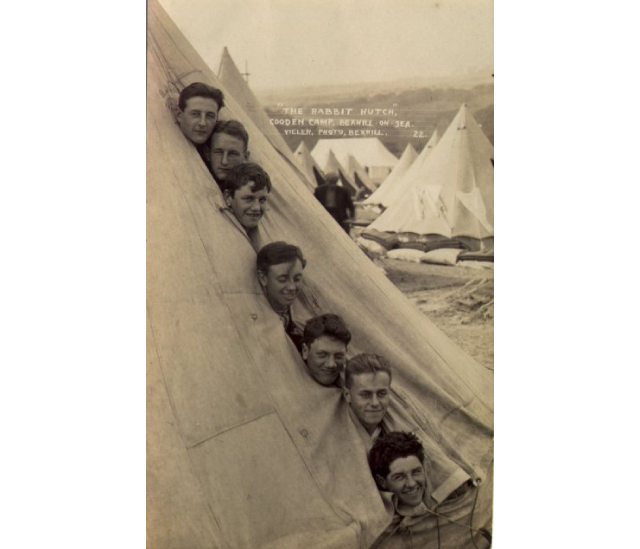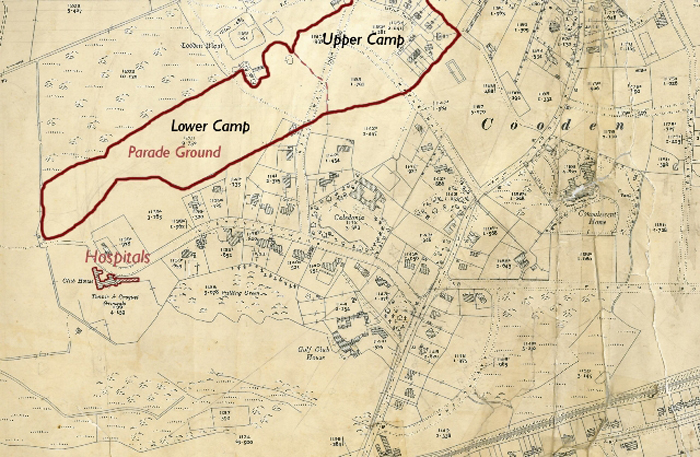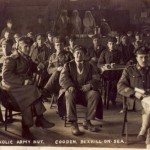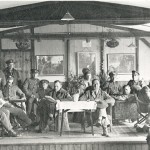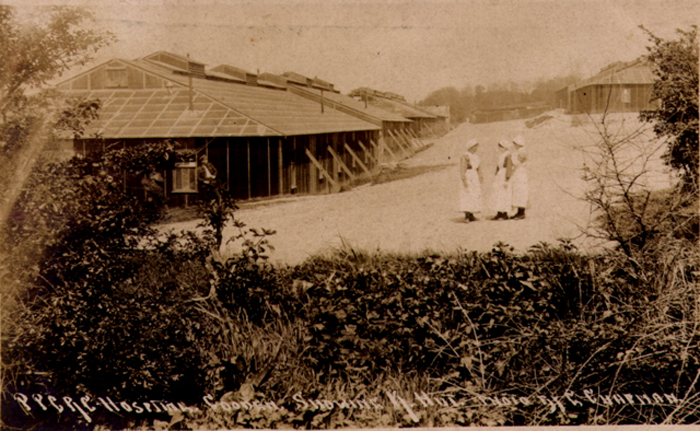Cooden Camp was a military training camp established in Bexhill at the start of the war.
Situated near Cooden Beach Golf Club and Henry Young’s Cooden Mount residence, on what had been farmland between Cooden Sea Road to the east, and Cooden Wood, to the west. The initial occupants of the camp were housed under canvas in the Lower Camp near the parade ground, with wooden huts constructed in the Upper Camp at the end of 1914.
The role and occupancy of Cooden Camp varied throughout the war. In September 1914, with permission from the War Office, Colonel Lowther began recruiting men for the Royal Sussex Regiment. 1,100 men from the south coast signed up in 56 hours. The 11th, 12th and 13th Battalions of the Royal Sussex Regiment became the 1st, 2nd and 3rd Southdown Battalions and were known as Lowther’s Lambs or the Southdowners. They were clothed, equipped and trained at Cooden Camp until the summer of 1915. In August one company of the 16thBattalion King’s Royal Rifles arrived and formed the 14thBattalion of the Royal Sussex Regiment with the remaining soldiers at the camp.
In September 1915 the character of Cooden Camp changed with the arrival of a 700 strong detachment of the South African Heavy Artillery, mobilised from the South Western African Campaign. In the following weeks these men were joined by two depots (training units) of the Royal Garrison Artillery, which included a small contingent from the Australian Artillery.
- Cooden Camp – Image courtesy of Claire Eden
- Cooden Camp, K o C Catholic Army Hut c1914 – Image courtesy of Claire Eden
During this period Cooden Camp housed a large number of artillery troops, stationed here before proceeding to firing training in Lydd, Kent. By the summer of 1916 the Royal Garrison Artillery depot controlled the entire site, and were renamed the No 1 Reinforcing Depot Royal Siege Artillery. The camp remained a training post for the next 18 months schooling soldiers of all rank, and at one period had over 150 commissioned officers.
In January 1918 Cooden Camp’s duty changed again. The departure of the artillery unit was followed by the arrival of the Canadian Engineers, who reconstructed the camp as a Canadian military convalescent hospital. Canadian troops were already a familiar sight in Bexhill during the War, as a Canadian Training School and Trench Warfare School were established at the Metropole Hotel on the seafront.
The first 131 patients arrived at Cooden Camp in March 1918 to receive treatment in the hospital that had the capacity to care for 2000 casualties. The Princess Patricia’s Canadian Red Cross Hospital brought together two existing Canadian hospitals from Uxbridge and Ramsgate. The first detachment arrived from Uxbridge on 13 January, followed on 15 January by a party from Ramsgate. The purpose of the relocation was to increase capacity. Although termed a ‘Red Cross’ hospital, it was actually funded by the Ministry of Overseas Military Forces of Canada in London. The main function of the hospital was to allow injured soldiers to convalesce before returning to France. The hospital was frequently visited and inspected by the Canadian military hierarchy and specialist medical personnel, such as dentists and surgeons.
Sport and recreation were a big part of life at the hospital as it was a way to build spirit and morale. It was surmised that if soldiers had confidence in one another on the sports field then they would have confidence in one another on the battlefield. The Princess Patricia Canadian Red Cross Hospital also had its own Concert Party, known as the ‘Parakeets,’ who entertained the sick and wounded at Canadian hospitals across Sussex. The hospital remained open until February 1919. The V.A.D hospital established as part of the camp in 1914, also operated until January 1919.
This story was submitted by Clare Eden, Bexhill Museum

